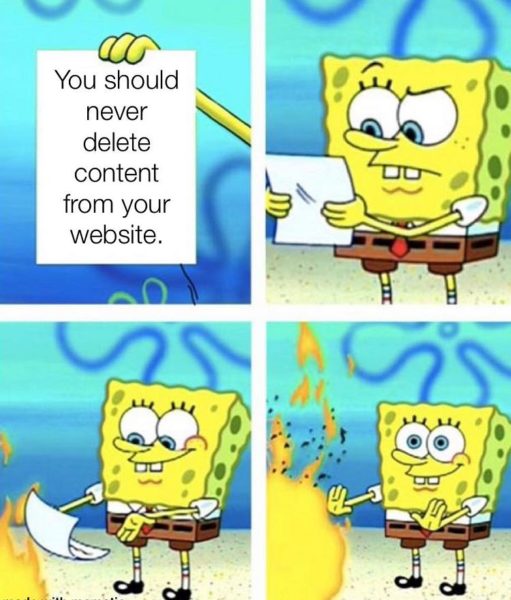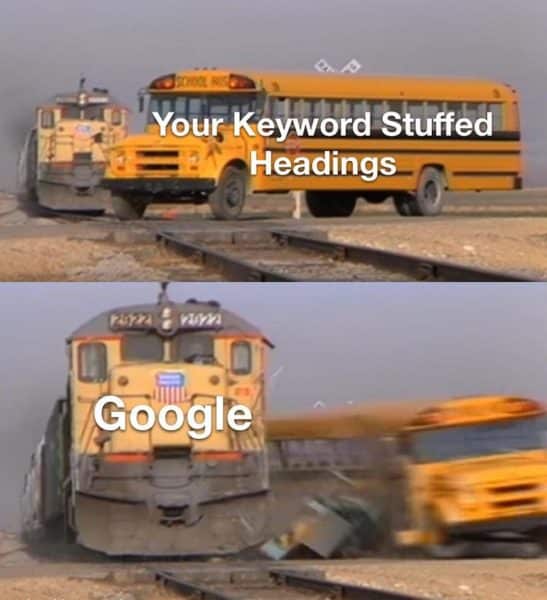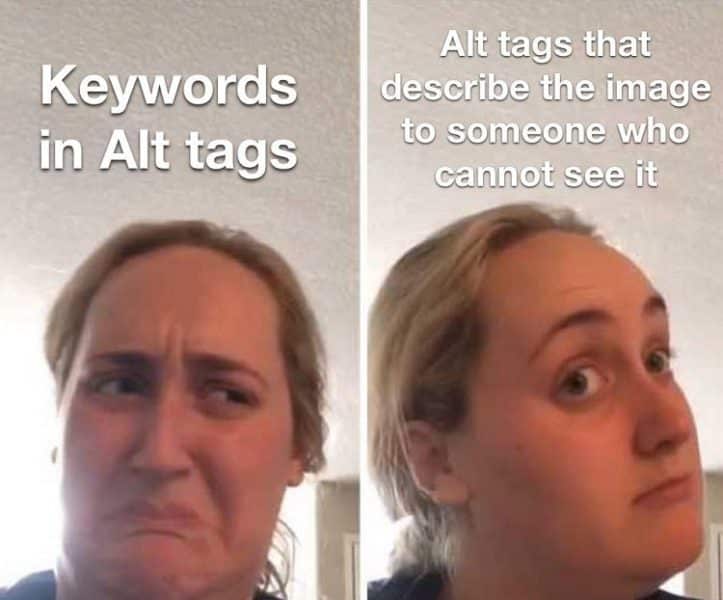The most common complaint I receive from audit clients and bloggers is the inability to “know which SEO advice to follow.”
Unlike search engines which can rank, re-rank, or penalize information or practices that are unethical or unscrupulous in nature, the same can’t be achieved by the average blogger weeding through multiple courses, gurus or podcasts.
Unfortunately, 2022 has taken things to a whole new level.
The amount of emails and instant messages I received from bloggers asking, “Is this true?” or “I was told to do this, what do you think?” cannot be quantified other than to say, “It was a lot.”
Executing a correct and competent SEO strategy has never been more challenging, especially in light of the explosion of new websites launched during the pandemic.
As such, understanding what advice is worthwhile and which is complete and utter garbage has never been more important.
To that end, I present some of the worst pieces of SEO advice I was asked about in 2022, with the hope that the answers will help you decide what not to do.
Worst SEO advice #1: “I should never remove content from my website.”

The benefits of removing old content from an existing site have been known and practiced for years.
Think of your site as a garden. All the content generating traffic, links, and regular social signals are your flowers. Everything that is not? Those are your weeds. Just like in a real garden, you can kill your flowers if you don’t pull those weeds.
Leaving expired, low-quality or thin content on your site can result in a myriad of bad SEO outcomes, including:
- Diluting your overall crawl budget.
- Reducing overall site authority.
- Creating page and keyword cannibalization issues.
- Reducing on-page UX and time-on-site metrics.
- Lowering sitewide revenue per thousand impressions (RPM) for ad income.
It’s also been well-documented by Google’s John Mueller that low-quality content on one part of a site can negatively impact the search rankings of the entire site.
Bottom line
If you can update and improve existing content, do that!
But if not, delete it, and move on. Think quality with your site content, not quantity.
Worst SEO advice #2: “All I need is to write longer content to rank higher.”

It has been stated repeatedly that word count is not a ranking factor with Google. And yet, daily, I run into clients who have been directed to write a longer resource as their main method to “recapture” a lost ranking or improve existing visibility.
When asked about word count, Mueller said, “just blindly adding content to a page will not make it (rank) better.”
What does help a resource is adding content that is useful to the audience.
For example, nobody wants to read a 2,000-plus-word treatise on artichoke hearts. As such, understanding what your audience is seeking and what is considered “useful” can still be confusing to the average site owner.
Bottom line
A content update or rewrite has to have a clear purpose and an understanding of why your page isn’t ranking in the first place.
- Is there an intent mismatch with your query?
- Does the page have technical deficiencies?
- Are you competing against much bigger sites?
These are just a few questions to answer before deciding “just to write a longer resource” for ranking consideration.
Worst SEO advice #3: “I should include my focus keyword in every page heading.”

During the “good ol’ days” of SEO, it was very common to optimize a page around a focus keyword by including the focus keyword in the title, the meta description, the URL, and every heading on the page.
For example, just a few years ago, a typical recipe post trying to rank for “banana cream pie” may have looked like this:
<H1> Best Banana Cream Pie <H2> Why this Banana Cream Pie is the Best <H2> Banana Cream Ingredients <H2> Step by Step to Make Banana Cream Pie <H2> Banana Cream Pie Questions & Answers <H2> Related Banana Cream Pie Recipes <H2> Banana Cream Pie (recipe card)
Unfortunately, following Google updates from November 2019, and later announced Core Updates in January and May 2020, a clear pattern emerged whereby bloggers who had been over-optimizing their headings (among other issues) suffered decimated ranking and traffic drops.
The pattern was incredibly easy to see in audits and online Facebook groups and was soon backed up by a Food Blogger Study by SEO firm Top Hat Rank published in February of 2020.
In the study, food blogs saw a 60% drop in direct Google search engine traffic to recipes and posts that had engaged in heading keyword over-optimization.
Fortunately, bloggers who went back through their site and started de-optimizing their headings ended up with recoveries by the May 2020 Core Update, or much later, when Google did their next announced update in December.
Bottom line
Any recommendation to stuff your headings with keywords is not only outdated advice but possibly dangerous for the average site in the current algorithmic climate.
Referencing your keyword naturally in the H1 and one or two other H2s seems fine. More than that, it will look spammy and should be avoided!
Worst SEO advice #4: “Alt text should be used for SEO keywords.”

Alt text, or alternative text, is one of the most important and misunderstood topics in all of SEO and accessibility. Having good and correct alt text for images is not just a simple SEO best practice, but it’s essential for people with visual disabilities who visit the site.
Alt text exists first and foremost to describe the image to someone who cannot see it. The focus is on those accessing the site with screen readers who cannot see the image and, as such, must have the images read out to them for descriptive purposes.
Nothing annoys visually impaired users more than visiting a site and seeing every image read out as “keyword – keyword – keyword.”
And yet, even today, with as much literature that exists on the correct use of alt text, this still happens more than it should!
Bottom line
Ditch the keywords and describe what is in the photo to someone who cannot see it.
Don’t say “image of” or “photo of” in your alt text. Be short but descriptive.
Finally, add a “period” at the end as a prompt for screen readers to know the alt text has completed.
Worst SEO advice #5: “Semrush says that I have toxic links and I must submit a disavow file.”

Oh, Semrush, you never disappoint!
Although the Semrush suite of tools is, by and large, a quality investment for users and SEOs alike, this is by far its biggest drawback. In this specific example, the tool fails miserably!
I have yet to run a crawl for a client with Semrush and have the tool not spit out a huge “Danger, Will Robinson! Danger!” warning when reviewing a link profile.
Semrush identifies random links as toxic and then recommends that the user submit a disavow file. The problem with this recommendation is it’s unnecessary and completely arbitrary.
Google is very clear that:
- The average site owner should never worry about toxic links.
- Arbitrary toxicity determinations by tools are not accurate.
- It’s all about selling the tools.
In fact, Google doesn’t even have a concept of toxic domains, and blindly following a tool that says “otherwise” should always be avoided.
Bottom line
Unless you have a manual action, or you know you built in bad links yourself, a disavow file is a complete waste of time for the average site owner.
Ignore the tools and move on to something else that will actually help move your site.
Final thoughts
You’ve heard that SEO is a marathon, not a sprint. As with any marathon, it’s all about training and preparation.
Don’t derail your SEO marathon by succumbing to poor advice baked into a course, a podcast or a guru trying to sell you their latest tool.
Instead, use a little common sense and push back against advice that “may” seem questionable when given. The site you save may be your own. Good luck out there!
The post The WORST SEO advice I heard this year (and what you should do instead) appeared first on Search Engine Land.
source https://searchengineland.com/worst-seo-advice-i-heard-this-year-and-what-you-should-do-instead-387204

0 Comments